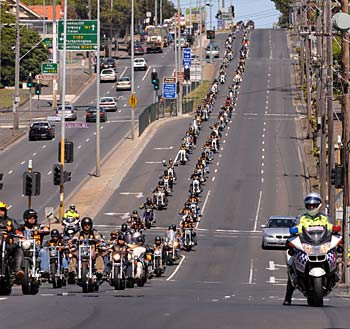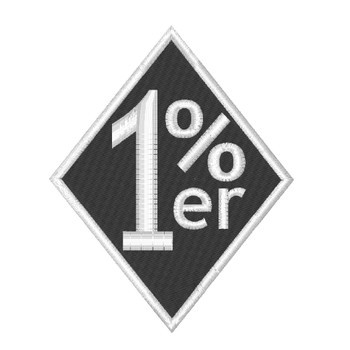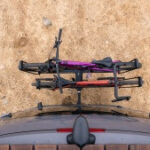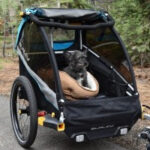The term “1%er biker” or “one percenter biker” immediately conjures images of leather-clad figures riding powerful motorcycles. But what does it truly mean to be a 1%er biker? This term is synonymous with “outlaw motorcycle clubs,” groups like the Hells Angels, Bandidos, Pagans, and Outlaws, setting them apart from the 99% of motorcyclists who are law-abiding citizens. This distinction, though decades old, continues to define a significant subculture within the motorcycle community.
The Origin of the 1%er Biker Label
The expression “1%er” wasn’t born in the shadows but rather in the aftermath of a highly publicized event: the 1947 Hollister Riot in California. In response to the media frenzy surrounding this incident, the American Motorcycle Association (AMA), aiming to reassure the public, declared that 99% of motorcycle riders were law-abiding citizens. This statement, intended to soothe public anxiety, inadvertently created a defiant counter-identity. Certain motorcycle clubs embraced the remaining 1%, proudly declaring themselves as the “one percenters” – those outside the mainstream, the rebels, the outlaws. This wasn’t just a label; it was a badge of honor, signifying a rejection of societal norms and an embrace of a different code.
Post-War Roots of Outlaw Motorcycle Clubs
The rise of outlaw motorcycle clubs, and consequently the 1%er biker identity, wasn’t accidental. It was deeply rooted in the socio-economic landscape of post-World War II America. The late 1940s saw a wave of veterans returning home, many struggling to readjust to civilian life. For those who had experienced the adrenaline and camaraderie of wartime, the quietude of domesticity felt lackluster. Simultaneously, the market was flooded with surplus Harley Davidson motorcycles, robust machines no longer needed by the military.
This convergence of factors was pivotal. Ex-servicemen, yearning for excitement and brotherhood reminiscent of their military days, found an outlet in motorcycles. These bikes weren’t just transportation; they were symbols of freedom and a means to recreate the intense bonds forged in war. Outlaw motorcycle clubs emerged as a way for these men to recapture a sense of purpose, adventure, and belonging outside the confines of conventional society.
 multiple one percenter clubs meeting
multiple one percenter clubs meeting
Prominent 1%er Motorcycle Clubs Worldwide
One percenter motorcycle clubs are not confined to geographical boundaries. They are a global phenomenon, with chapters extending across continents. Clubs like the Hells Angels and Outlaws, for example, are structured into local chapters, allowing for a widespread presence while maintaining a centralized club identity and rules. These clubs operate as organized entities, often with legal structures and even merchandise, like “supporter gear,” available to the public.
Some of the most recognized 1%er motorcycle clubs globally include:
- Hells Angels Motorcycle Club
- Outlaws Motorcycle Club
- Bandidos Motorcycle Club
- Pagans Motorcycle Club
- Mongols Motorcycle Club (though not mentioned in the original article, it is a significant 1%er club)
- Vagos Motorcycle Club (also a major 1%er club)
The Significance of the 1% Patch
For those identifying as a 1%er biker, the “1%” patch is a potent symbol. Worn prominently on their vests or jackets, this patch is an immediate visual declaration of their affiliation and beliefs. It signifies their embrace of the outlaw biker lifestyle and their separation from mainstream motorcycle culture and society at large. It’s a clear marker of identity within the biker world, instantly recognizable and carrying significant weight.
Media Portrayal and the Reality of 1%er Bikers
Media coverage of 1%er motorcycle clubs often leans heavily on sensationalism, focusing on crime and violence. While it’s undeniable that some members of these clubs have been involved in criminal activities, the media narrative often disproportionately emphasizes the negative aspects. This can create a skewed public perception, painting all 1%er bikers with the same brush of criminality.
It’s important to recognize that while criminal activity exists within some outlaw motorcycle clubs, the vast majority of their “violence” is often internally focused, related to club rivalries and territorial disputes. For the average person, the adage “live and let live” often applies – avoiding involvement with club activities generally means avoiding conflict.
 one percenter bikers and police
one percenter bikers and police
Government Scrutiny and Outlaw Motorcycle Clubs
Governments worldwide have taken notice of outlaw motorcycle clubs and their activities. In the United States, federal agencies have utilized the RICO (Racketeer Influenced and Corrupt Organizations Act) statute, initially designed to combat the Mafia, to target major 1%er clubs like the Hells Angels, Bandidos, Outlaws, and Pagans. This legal approach reflects the government’s view of these clubs as organized criminal enterprises.
Outside the U.S., similar measures are being explored and implemented, with governments seeking to restrict club activities and member associations through legislation mirroring RICO. These governmental actions underscore the ongoing tension between outlaw motorcycle clubs and law enforcement, highlighting the complex and often contentious position of 1%er bikers in society.
Understanding the 1%er biker identity requires looking beyond media stereotypes and recognizing the historical, social, and cultural factors that shaped this subculture. It’s a world of brotherhood, rebellion, and a distinct code of conduct that continues to fascinate and sometimes, concern, the wider world.



